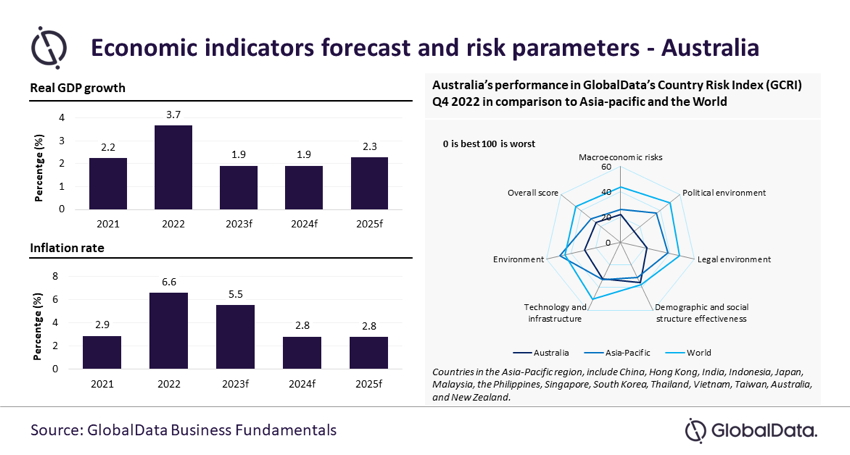
The Australian economy is facing several challenges such as higher cost of living, tighter monetary policy implemented by the Reserve Bank of Australia, and a decrease in real wages. Consequently, the country's economic growth, which increased by 3.7% in 2022 due to rising household spending and an increase in exports after the lifting of COVID-19 restrictions, is projected to slow down significantly to 1.9% in 2023, forecasts GlobalData.
GlobalData's latest report, "Macroeconomic Outlook Report: Australia," reveals that the enforcement of Regional Comprehensive Economic Partnership Agreement (RCEP), a free trade agreement in Indo-Pacific region from January 2022, is expected to bring multiple opportunities for the Australian agricultural and mining industry over the next decade.
Along with it, the upgradation of the ASEAN-Australia-New Zealand Free Trade Agreement (AANZFTA), which is expected to be officially signed in spring 2023, will further reinforce trade related activities. The country is anticipated to witness an export led growth with the exports share in GDP to rise from 25% in 2021 to 32.2% in 2025.
Indrajit Banerjee, Economic Research Analyst at GlobalData, comments: "To reinforce economic activities, Australia has undertaken several development projects that are expected to significantly boost construction and allied activities and create jobs opportunities."
Some of the ongoing projects include railway infrastructure project of AUD17.9 billion ($13.6 billion), M12 Motorway project of AUD2 billion ($1.5 billion), and rail link to Melbourne airport project of more than $5 billion. As of September 2022, many states in Australia are easing certain terms of visa application for skilled foreign workers to fill in the resource gap for the job opportunities created by these projects.
In terms of sectors, financial intermediation, real estate, and business activities contributed 22.3% to the gross value added (GVA) in 2022, followed by the mining, manufacturing, utilities (21.2%), and the wholesale, retail, and hotels sector (9.9%).
According to GlobalData, in nominal terms, the three sectors are forecast to grow by 4.9%, 5.4% and 2.6%, respectively, in 2023. Meanwhile, the lifting of restrictions are expected to boost the tourism and hotel business activities. According to GlobalData estimates, the country received more than 2.2 million international visitors in 2022, which is forecast increase to 8.4 million in 2023.
Australia is categorized as a very low-risk nation and ranks 21st out of the 153 nations in GlobalData Country Risk Index (GCRI Q4 2022). The country's risk score is lower in the parameters of political environment, macroeconomic, social, and environmental risk when compared to the average of Asia-Pacific nations.
Banerjee adds: "On the flip side, high inflation in Australia remains a key impediment to the economic growth prospects. The inflation rate rose to 7.8% in Q4 2022, the highest since Q1 1990, driven by 9.2% rise in food prices which was highest since Q3 2006. The inflation rate is projected to ease to 5.4% in 2023, which is much higher than the central bank's target of 2-3%.
To tame inflation, policy rate has been increased by a total 350bps during January 2022 to March 2023. Higher borrowing costs can discourage businesses from taking loans to invest in new projects or expand their operations. Reduced investment and borrowing can lead to lower economic growth, as businesses may be less likely to expand their operations.
Banerjee concludes: "Rising tourist inflows, regional agreements, and growing demand of lithium, copper, and nickel (leading producer) are expected to aid the economic growth prospects of the Australian economy over the next decade. Although China (largest trading partner) adopted a plan to reduce its dependency on foreign resources, the recent trade agreements with other APAC nations will keep the external sector of Australia buoyed."
